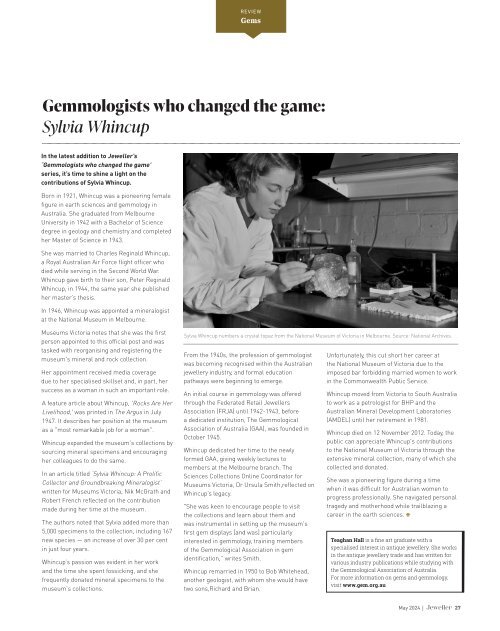Jeweller - May 2024
Create successful ePaper yourself
Turn your PDF publications into a flip-book with our unique Google optimized e-Paper software.
REVIEW<br />
Gems<br />
Gemmologists who changed the game:<br />
Sylvia Whincup<br />
In the latest addition to <strong>Jeweller</strong>’s<br />
‘Gemmologists who changed the game’<br />
series, it’s time to shine a light on the<br />
contributions of Sylvia Whincup.<br />
Born in 1921, Whincup was a pioneering female<br />
figure in earth sciences and gemmology in<br />
Australia. She graduated from Melbourne<br />
University in 1942 with a Bachelor of Science<br />
degree in geology and chemistry and completed<br />
her Master of Science in 1943.<br />
She was married to Charles Reginald Whincup,<br />
a Royal Australian Air Force flight officer who<br />
died while serving in the Second World War.<br />
Whincup gave birth to their son, Peter Reginald<br />
Whincup, in 1944, the same year she published<br />
her master’s thesis.<br />
In 1946, Whincup was appointed a mineralogist<br />
at the National Museum in Melbourne.<br />
Museums Victoria notes that she was the first<br />
person appointed to this official post and was<br />
tasked with reorganising and registering the<br />
museum's mineral and rock collection.<br />
Her appointment received media coverage<br />
due to her specialised skillset and, in part, her<br />
success as a woman in such an important role.<br />
A feature article about Whincup, 'Rocks Are Her<br />
Livelihood,' was printed in The Argus in July<br />
1947. It describes her position at the museum<br />
as a "most remarkable job for a woman".<br />
Whincup expanded the museum's collections by<br />
sourcing mineral specimens and encouraging<br />
her colleagues to do the same.<br />
In an article titled ‘Sylvia Whincup: A Prolific<br />
Collector and Groundbreaking Mineralogist’<br />
written for Museums Victoria, Nik McGrath and<br />
Robert French reflected on the contribution<br />
made during her time at the museum.<br />
The authors noted that Sylvia added more than<br />
5,000 specimens to the collection, including 167<br />
new species — an increase of over 30 per cent<br />
in just four years.<br />
Whincup’s passion was evident in her work<br />
and the time she spent fossicking, and she<br />
frequently donated mineral specimens to the<br />
museum's collections.<br />
Sylvia Whincup numbers a crystal topaz from the National Museum of Victoria in Melbourne. Source: National Archives.<br />
From the 1940s, the profession of gemmologist<br />
was becoming recognised within the Australian<br />
jewellery industry, and formal education<br />
pathways were beginning to emerge.<br />
An initial course in gemmology was offered<br />
through the Federated Retail <strong>Jeweller</strong>s<br />
Association (FRJA) until 1942-1943, before<br />
a dedicated institution, The Gemmological<br />
Association of Australia (GAA), was founded in<br />
October 1945.<br />
Whincup dedicated her time to the newly<br />
formed GAA, giving weekly lectures to<br />
members at the Melbourne branch. The<br />
Sciences Collections Online Coordinator for<br />
Museums Victoria, Dr Ursula Smith,reflected on<br />
Whincup’s legacy.<br />
"She was keen to encourage people to visit<br />
the collections and learn about them and<br />
was instrumental in setting up the museum's<br />
first gem displays [and was] particularly<br />
interested in gemmology, training members<br />
of the Gemmological Association in gem<br />
identification,” writes Smith.<br />
Whincup remarried in 1950 to Bob Whitehead,<br />
another geologist, with whom she would have<br />
two sons,Richard and Brian.<br />
Unfortunately, this cut short her career at<br />
the National Museum of Victoria due to the<br />
imposed bar forbidding married women to work<br />
in the Commonwealth Public Service.<br />
Whincup moved from Victoria to South Australia<br />
to work as a petrologist for BHP and the<br />
Australian Mineral Development Laboratories<br />
(AMDEL) until her retirement in 1981.<br />
Whincup died on 12 November 2012. Today, the<br />
public can appreciate Whincup's contributions<br />
to the National Museum of Victoria through the<br />
extensive mineral collection, many of which she<br />
collected and donated.<br />
She was a pioneering figure during a time<br />
when it was difficult for Australian women to<br />
progress professionally. She navigated personal<br />
tragedy and motherhood while trailblazing a<br />
career in the earth sciences.<br />
Teaghan Hall is a fine art graduate with a<br />
specialised interest in antique jewellery. She works<br />
in the antique jewellery trade and has written for<br />
various industry publications while studying with<br />
the Gemmological Association of Australia.<br />
For more information on gems and gemmology,<br />
visit www.gem.org.au<br />
<strong>May</strong> <strong>2024</strong> | 27

















